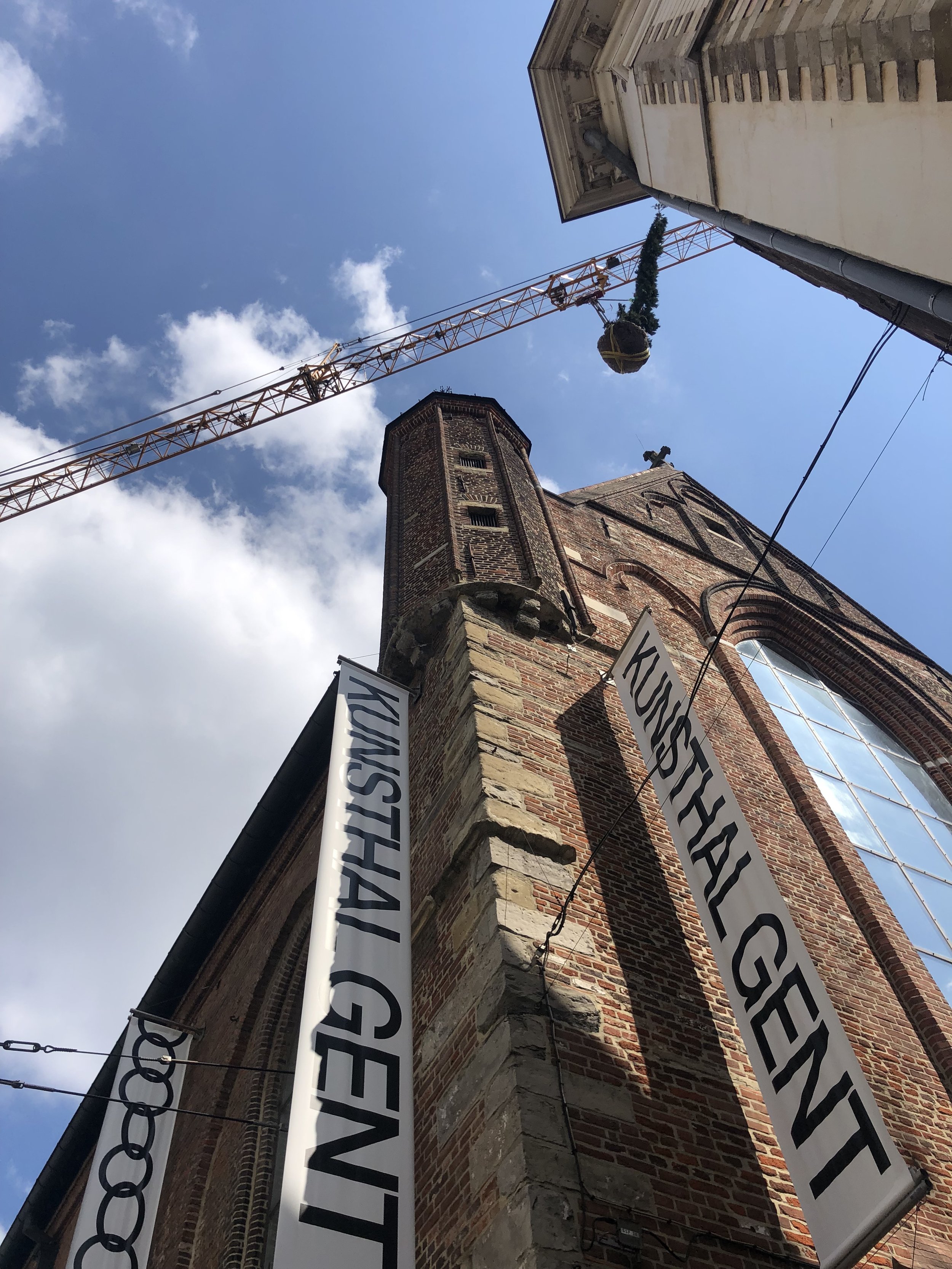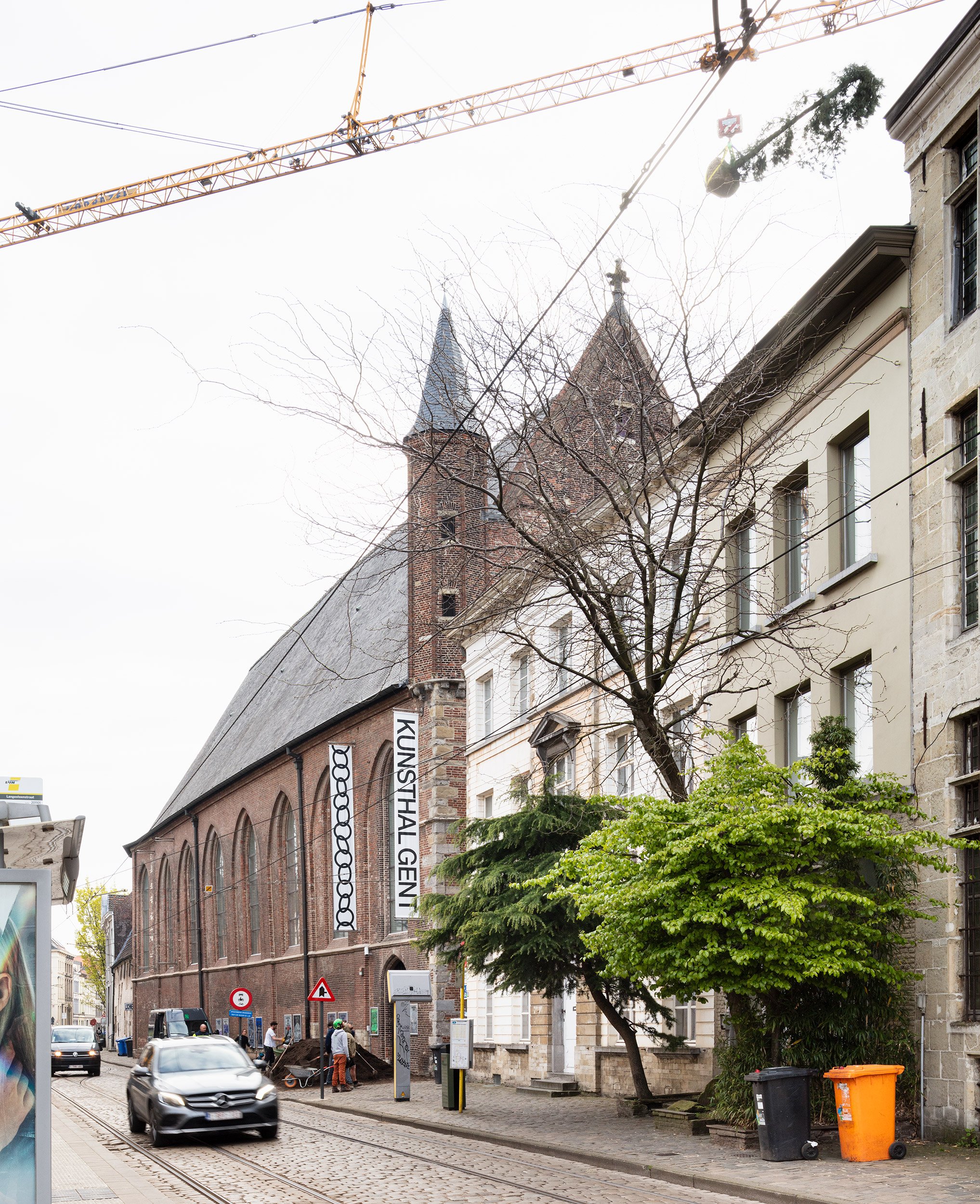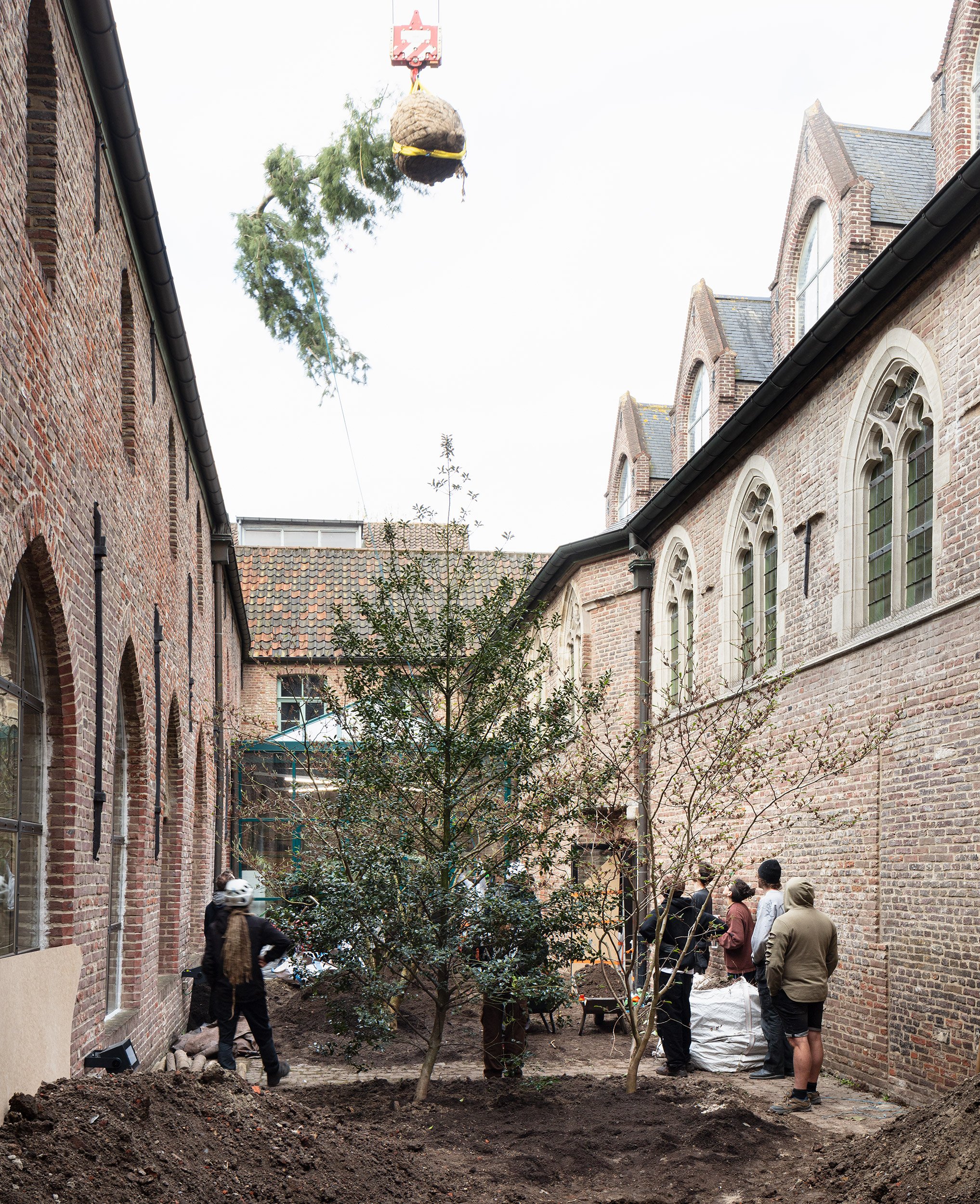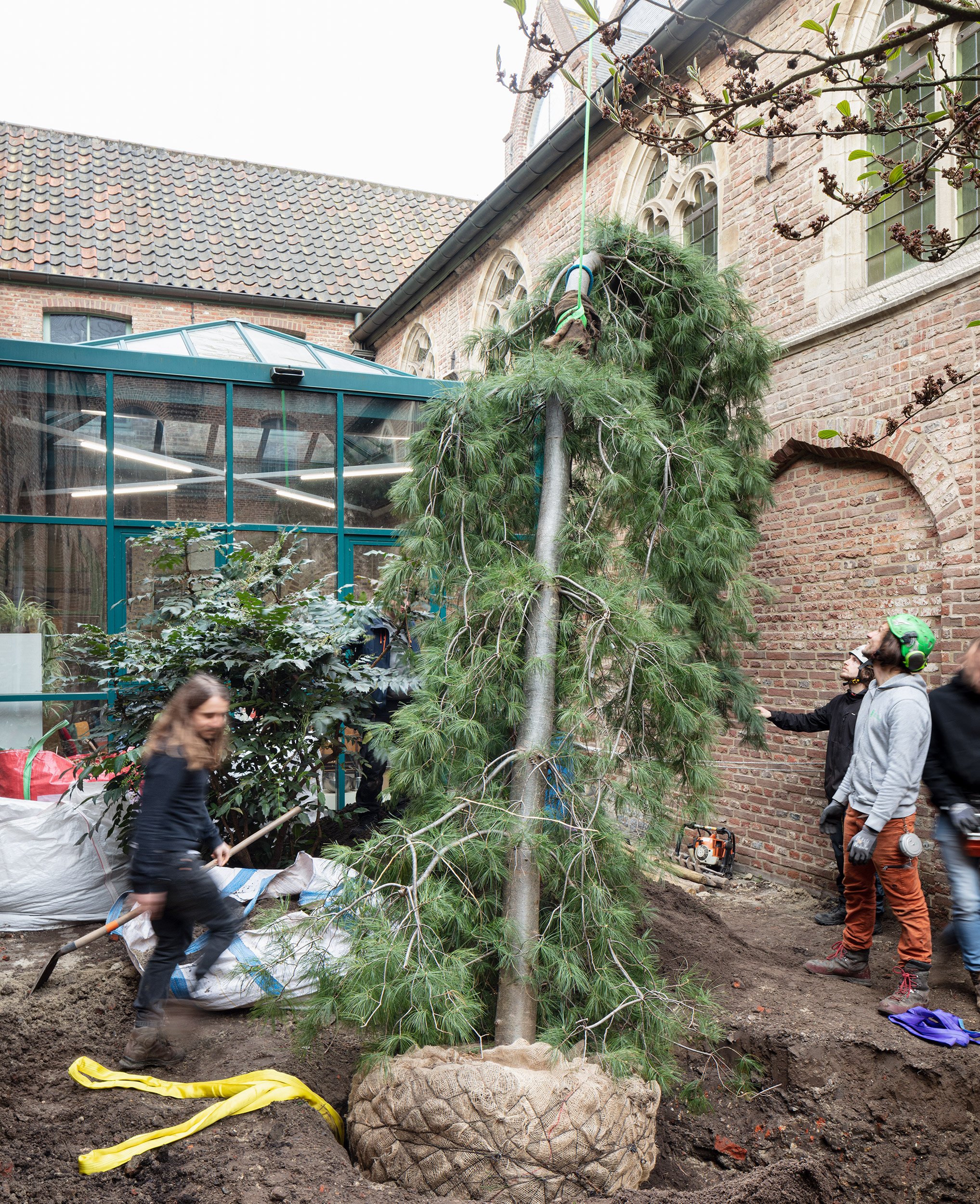Ben Thorp Brown | Kunsthal Gent
Photo by Michiel de Cleene
Ben Thorp Brown
Kunsthal Gent
Cura’s Garden
26.05—∞Introduction
In the courtyard, a grove of soaring trees invites an upward gaze. A dense mist fills the space. The atmosphere is heavy, our vision is blurred. Water trickles from a pipe into a ceramic tile fountain. There is the sound of a voice from afar, and it smells like fresh earth.
Cura’s Garden is an “Endless Exhibition” by Ben Thorp Brown in the courtyard of a former 13th-century monastery in Ghent, Belgium now run by Kunsthal Gent. Unfolding over time through choreographed and natural processes, this installation creates an idyllic and foreboding landscape that deepens links between our senses, emotions, and the earth itself.
Cura’s Garden is named after the ancient Roman goddess Cura, the personification of care, and a returning figure in Ben Thorp Brown’s work about humanity’s relationship with architecture and the environment. Following Brown’s 2019 film Cura, this work creates a new space for attention to landscape that transcends its own boundaries. Gardening itself is an act of empathy with non-human living things. The garden evokes images of the sublime, metamorphosis, and regeneration and invites visitors to develop a relationship with this place over time.
Working in collaboration with landscape designer, Jan Minne, a garden was planned to create a vision of Arcadia. A grove of large trees was carefully selected for their unique forms designed to make people feel both wonder and unease. These plants are situated amidst a fog sculpture titled Embrace that fills the environment with a cloud of mist that heightens the everyday into a cinematic environment. The atmosphere alters our senses, as the space in front of us becomes fully obscured. In this unique spatial and sonic environment, at the center of the garden is a ceramic sculpture Fountain (After Cura). In the myth of Cura the human body was formed out of clay alongside a riverbank, and the goddess Cura sought to name the body after caring for it. The sculpture depicts a human form as it emerges from clay and water. Additionally, a sound sculpture, Memento, of Cura’s voice as performed by Joan La Barbara is found in the garden.
Fountain (After Cura), 2023, Ben Thorp Brown, May 2023
Artist Climate Statement
I believe art can help us comprehend the state of emergency we live in, and I intend Cura’s Garden to produce a space of feeling in response to the crisis that is unfolding. This project imagines a garden as a “holding environment” where a state of unease alongside a feeling of safety is paramount for the transformation into a new way of being. The garden is intended as a place to wander and to observe a landscape composed of an ongoing system of relationships.
Practically speaking, I’ve been addressing ways to reduce waste in my production process and manage energy usage in my studio. In 2018, I supported the conservation of land in the Guatemalan cloud-forest through the sale of my artwork with the not-for-profit Art in Acres. Permanently conserving the land avoids the release of carbon emissions during deforestation while simultaneously supporting an ecosystem's biodiversity, watershed, and the local community. This mountainous location is the watershed of thirteen villages and is home to critically endangered biodiversity, including 265 documented bird species.
Kunsthal Gent Climate Statement
Sustainability commitments
Given the current emergency of climate change and the art world's not insignificant role in it, Kunsthal Gent decided to introduce some small but important commitments to the handling of everyday necessities. These include vegetarian catering, fair trade coffee beans, ecological printing paper, the promotion of train - and car-sharing, the usage of an ethical bank account, and a membership of Greentrack Gent. After opening Kunsthal, the city hall invested in a new heating system for the building. However, with the start of the war in Ukraine and the associated gas prices, the organization decided to keep the temperature at 10 degrees C (50 F) only, due to the size of the building.
Endless exhibition
Kunsthal Gent decided to counteract the usual pace of the art world and present an endless exhibition. The program has been running since day one, which started in 2018, and was inspired by a text by Prem Krishnamurthy. The endless exhibition is slowly growing and always changing. Curators and artists are invited to develop a contribution to an exhibition that has no end date. Every added piece therefore always has to go into a conversation with all the artists involved. This performative proposal poses timely questions of space, waste, labor, and questions the autonomy and 'untouchability' of individual, finished artworks.
Cura’s Garden
One such artist is Ben Thorp Brown. He was invited to redesign one of the gardens of the 14th-century monastery. We were aware of the carbon footprint of hosting an American artist, but in as many ways as possible tried to work on production locally and thoughtfully. The trees and plants, selected with the help of local garden architect Jan Minne, were delivered by truck from a local Belgian tree nursery and lowered into the garden by crane over the monastery. A large team of paid volunteers prepared the excavations in the garden days in advance to minimize the labor on the day itself. A team from Kunsthal Gent worked in collaboration with Ben to complete the installation of the sculptures in the garden.
Fountain (After Cura), 2023, Photo by Michiel de Cleene, May 2023
Carbon Emissions: 4.24 tCO2e
Carbon emissions calculated from the production of this show are 4.24 tonnes.
Additionally, we calculated the amount of time it would take for the nine trees in the show to naturally sequester the carbon used in the production.
TRAVEL AND SHIPPING: 3.32 tCO2e
Ben Travel: 2 RT Flights: 3.24 tCO2e. Local train travel in EU:0.03 tCO2e. Taxis to airport in NY: 0.04 tCO3e.
Jan Travel: 2 RT train 99 km: 0.01 tCO2e. 2 RT by car: 0.02 tCO2e.
In June of 2021, I made my first site visit to Kunsthal Gent for this project. I was already in Belgium for a group exhibition at STUK in Leuven, Belgium. Within Belgium, I traveled locally by train.
During the course of the production phase of the project, I traveled from NY to Belgium 1x for installation and shipping and 1x for the final installation and opening. I plant to make subsequent trips to visit the garden for events and a publication, however, I plan on organizing visits efficiently. The shipping of the ceramic was transported via checked luggage using reusable crates. During the course of production, a key collaborator named Jan Minne traveled from Brussles to Ghent via train and car several times.
SCULPTURE PRODUCTION: 0.19 tCO2e
Skutt 1027 kiln 11.52kW rating, for 12 hours (estimated 6 hours actually firing) 69.12 kW per each firing to Cone 6 2200 Fahrenheit, estimated 10 times: 0.14 CO2e
Clay and materials transport, multiple car trips to gather materials 151 miles: 0.05 tCO2e
Comprising new work in glazed ceramic made in upstate NY, these new sculptures were developed through experimentation with a range of clay, glaze, kiln effects, and the botanical landscape itself. Research into specific uses of clay and glaze for this outdoor environment were tested. The work comprises a total of 64 pieces of handmade, sculptural tiles. The fountain tiles are mounted onto a wooden/polyester base that is hidden in the ground, and a drain, water tank, and electrical pump circulate water through a copper pipe that emerges from the ground.
LANDSCAPING 0.63 tCO2e
2 Trucks with tree delivery, 3000kg, 234km total distance: 0.4 tCCO2e
1 Crane, 3000 kg, 128 km total distance 0.22 tCCO2e
MK 88-4.1 Crane energy use for 7 hours, 168 kwh 0.03 tCO2e
1 Truck delivery with small plants, 0.01 tCO2e
Jan and myself worked to source trees from nurseries in Belgium. 6 large trees were transported on trucks across the country from Aarschot, Belgium. We tested the soil in the garden, and after considerable digging, realized that the soil quality was very rocky and so we added soil into this environment. In the process, the rocks were removed to a nearby garden to create a path into this space.
Because of the unique architectural environment of KunsthalGent, we needed to lift the trees over a wall into the garden, and this involved renting a crane and a team of arborists (Kjel Dupon) helped with the installation of the trees.
The extent of the program and implemented projects at Kunsthal Gent is only made possible by the help of numerous volunteers. Gradually, a strong volunteering network was established, consisting of young and old helpers. Most of the volunteers live in the close neighborhood in Patershol. The volunteers are paid with a voluntary fee of 40€/a day and provided with free lunch. By being part of a network in the art scene, a lot of young students and retired people benefit from the community, forming around Kunsthal. The organization invites everyone to a yearly drink and gives exclusive early access to exhibitions. The system of volunteer work has nurtured an intimate and devoted spirit over time.
MIST SCULPTURE: 0.05
Shipping of mist system 258 Km: 0.04 tCO2e
Pumping 4 Lt of water per minute for 12 hours a week: .15 kw, 12 hours per week, 1.8kwh per week, estimated 0.01 tCO2 per year
The use of water is being tracked, and we will observe and adjust this usage depending on the conditions we observe. The water will affect the climate of the space, adding a high degree of moisture to the atmosphere. This will give the plants water, but also it will create conditions for a particular kind of environment that will support the growth of moss and other non-vascular plant life. The estimated flow rate of the mist machine is 4L per minute. A garden hose typically uses 15L per minute. The mist system will be running at a maximum for 2 days a week for a total of 6 hours using 1440L of water per week.
Sequestration
Trees reduce the carbon in the atmosphere by storing carbon as they grow. Cura’s Garden is composed of 9 trees and many small bushes and plants. While a garden of this scale makes a minuscule impact on our current carbon expenditure at large, as a part of the process of making a climate impact report for an exhibition, we were interested in recording the naturally occurring process of capturing carbon that this number of trees provides over time. Making an accurate calculation of carbon capture depends on many factors such as the species, lifespan, size of the tree, and amount of growth. For the purpose of this report and speculative inquiry, we are going to use an estimate from the European Environmental Agency that one mature tree stores 48lbs (22kg) of carbon dioxide from the atmosphere each year. It is estimated that 30-45 trees would be necessary to offset 1 tonne of carbon dioxide emissions in a year. Based on these estimates of these trees alone, it will take more than 20 years to offset the carbon usage from the travel and production of this exhibition, or exactly 21.6 years according to these estimates.
CARBON SEQUESTRATION CALCULATION
One mature tree stores 48lbs (22kg) of carbon dioxide from the atmosphere each year
9 trees x 48 lbs equal 432 lbs of carbon sequestered for 1 year
5 years, 2160 lbs of carbon, (.97 tCO2e)
10 years, 4320 lbs of carbon, (1.95 tCO2e)
The 9325.5 lbs of carbon from production will be sequestered in 21.6 years.
Waste Report
Reuse: (to be reused for the same purpose as the original use)
Pelican cases
Repurpose: (To be kept, sold, or donated and used for a different purpose in the future)
Rocks made into a path in next door garden
Landfill (items sent to a landfill)
Some small plants were pruned and removed from the garden
Supporting people
Responding to the climate crisis requires movement building, community connection, and sector-wide collaboration. How did this project contribute to a culture of collective action?
Asked artists, vendors, collaborators and/or other stakeholders about their climate action, specifically funding partners Creative Capital and Shifting Foundation about their climate action.
Invited artists, vendors, collaborators, and/or other stakeholders to participate in the CIR.
Encouraged other artists or presenting partners to do a CIR.
Plan to offer support to others who want to do a CIR for the first time.
Additional Thoughts
I’ve learned a lot from the process of researching this report and making these calculations. I found the carbon emissions and sequestration calculation particularly interesting because it helped make the scale of the problem more tangible. I think the process itself is really an important exercise, and I’m interested in supporting other artists seeking to make a climate impact report.
Credits
This report was generated by Ben Thorp Brown, Carolina Munoz Awad (studio assistant), Antonia Schreiber (Kunsthal Gent), Valentijn Goethals (Kunsthal Gent).
Thanks to Artists Commit mentor Deville Cohen for supporting the creation of the report.
We calculated the carbon use through the GCC calculator: https://galleryclimatecoalition.org/carbon-calculator/
We used the estimates from EEA to estimate sequestered carbon: https://www.eea.europa.eu/articles/forests-health-and-climate-change/key-facts/trees-help-tackle-climate-change
Link to exhibition page:
https://kunsthal.gent/en/exhibitions/curas-garden













